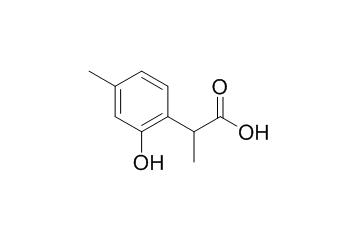2-(2'-Hydroxy-4'-methylphenyl)propionic acid
2-(2'-Hydroxy-4'-methylphenyl)propionic acid is a natural product from Thymus serpyllum L.
Inquire / Order:
manager@chemfaces.com
Technical Inquiries:
service@chemfaces.com
Tel:
+86-27-84237783
Fax:
+86-27-84254680
Address:
1 Building, No. 83, CheCheng Rd., Wuhan Economic and Technological Development Zone, Wuhan, Hubei 430056, PRC
Providing storage is as stated on the product vial and the vial is kept tightly sealed, the product can be stored for up to
24 months(2-8C).
Wherever possible, you should prepare and use solutions on the same day. However, if you need to make up stock solutions in advance, we recommend that you store the solution as aliquots in tightly sealed vials at -20C. Generally, these will be useable for up to two weeks. Before use, and prior to opening the vial we recommend that you allow your product to equilibrate to room temperature for at least 1 hour.
Need more advice on solubility, usage and handling? Please email to: service@chemfaces.com
The packaging of the product may have turned upside down during transportation, resulting in the natural compounds adhering to the neck or cap of the vial. take the vial out of its packaging and gently shake to let the compounds fall to the bottom of the vial. for liquid products, centrifuge at 200-500 RPM to gather the liquid at the bottom of the vial. try to avoid loss or contamination during handling.
Foods.2023, 12(6):1130.
Int J Mol Sci.2023, 24(8):7300.
Molecular Simulation2023, 49(8):799-815.
Biomed Pharmacother.2024, 179:117346.
Foods.2021, 10(6):1378.
Molecules.2019, 24(12):E2286
Malaysian Journal of Analytical Sciences2022, 26(2):360-369.
Dicle Tip Dergisi2020, 47(2),423-430.
Analytical Letters.2020, doi 10.1008
J Korean Soc Food Sci Nutr2020, doi: 10.3746.
Related and Featured Products
Drug Metab Dispos. 2003 Oct;31(10):1208-13.
Metabolism of (R)-(+)-menthofuran in Fischer-344 rats: identification of sulfonic acid metabolites.[Pubmed:
12975329 ]
(R)-(+)-Menthofuran is a metabolite of (R)-(+)-pulegone, the chief constituent of pennyroyal oil. Menthofuran has been shown to account for a significant percentage of pulegone toxicity through further metabolism to a reactive intermediate, an enonal (2-Z-(2'-keto-4'-methylcyclohexylidene)propanal). Hydration of the enonal followed by a 1,4-dehydration and rearrangement gives rise to diastereomeric (-)-mintlactone and (+)-isomintlactone (mintlactones).
We have conducted disposition studies on pulegone as part of the National Toxicology Program initiative in herbal medicines and dietary supplements, and have reported previously unknown urinary metabolites of pulegone.
METHODS AND RESULTS:
Comparative metabolism studies of 14C-labeled menthofuran in Fischer-344 (F344) rats were carried out to determine urinary metabolites of pulegone that are derived from the menthofuran pathway. Three sulfonic acid metabolites, namely, hexahydro-3,6-dimethyl-1-(2-sulfoethyl)-2H-indol-2-one, hexahydro-3,6-dimethyl-7a-sulfo-2(3H)-benzofuranone, and 2-sulfomenthofuran, were identified in urine of treated rats. Formation of these metabolites may be derived from reactions of the enonal with taurine or glutathione (GSH) (or sulfite ion). Other identified urinary metabolites of menthofuran could be attributed to further metabolism of mintlactones. Further hydroxylation of mintlactones could give 7a-hydroxymintlactone and 6,7a-dihydroxymintlactone. Glucuronidation or reduction of 7a-hydroxymintlactone could give rise to the major metabolites 7a-hydroxymintlactone glucuronide and 2-[2'-keto-4'-methylcyclohexyl]propionic acids. Glucuronidation or repeated hydroxylation/dehydration of 2-[2'-keto-4'-methylcyclohexyl]propionic acids could result in formation of hexahydro-3,6-dimethyl-7a-hydroxy-2(3H)-benzofuranone glucuronide and 2-(2'-Hydroxy-4'-methylphenyl)propionic acid.
CONCLUSIONS:
2-(Glutathion-S-yl)menthofuran, a GSH conjugate of the enonal that has been partially characterized in bile of rats dosed with pulegone, is at most a minor biliary metabolite of menthofuran in rats.



